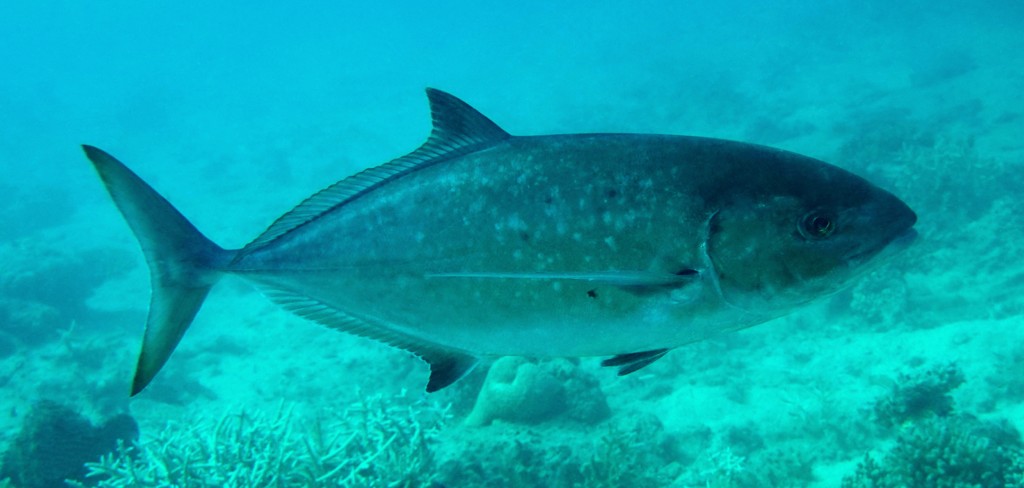TURRUM GYMNOSTETHUS - (CUVIER, 1833)
Picture courtesy of: Yves Thévenet
Carangue balo, Carangue blanche, Carangue à poitrine nue, Bleeker's jackfish, Bludger, Bludger trevally, Naked breast trevally, Xaréu oliva, Karang balo, Jurel balo, Nøgenbrystet trevalle, Andaman-aji, アンダマンアジ, 甘仔鱼, 裸胸若鰺,
Synonymes
Carangoides gymnostethoides (Bleeker, 1851)
Carangoides gymnostethus (Cuvier, 1833)
Caranx gymnostethoides (Bleeker, 1851)
Caranx gymnostethus (Cuvier, 1833)
Ferdauia claeszooni prestonensis (Whitley, 1947)
----------------------------
Description
Dorsal spines (total): 9; Dorsal soft rays (total): 28-33; Anal spines: 3; Anal soft rays: I + 24-27; Pectoral fin rays: I + 18-20; Curved lateral line scales: 78-80; Straight lateral line scales: 15-19 scales, 21-27 scutes; Vertebrae: 10 + 15; Gill rakers: 7-9 + 19-22 = 28-31. Body elongate-ovate. Dorsal profile more convex than ventral. Snout blunt, longer than eye diameter. Villiform teeth in an angular patch, without a posteromedian extension on vomer. Breast naked ventrally to distinctly behind origin of pelvic fin; Laterally, naked area of breast extending to naked base of pectoral fin. Curved portion of lateral line gently to moderately arched, with junction of curved and straight parts below 16th to 20th ray of second dorsal fin. Max. length: 90.0 cm TL, common length: 45.0 cm SL. Max. published weight: 14.5 kg. Depth range: 6 - 100 m.
Color
In specimens up to 200 mm, body silver to silvery green with a few scattered golden spots on sides; Dark line running obliquely through eye, fading with age. In larger specimens, body green to blue green above, silver below; With or without gold to golden brown spots (usually less than 30) on sides. Dorsal, anal, caudal and pelvic fins olive green; Soft dorsal and soft anal fins often with white tips; Pectoral fins hyaline.
Etymology
Turrum: word of uncertain origin but is probably Australian aboriginal and refers to any of several species of trevally. A genus of trevallies of large size and with the general facies of Caranx.
gymnostethus: from Greek, Gymnos = bare or naked + from Greek, stethos = related to sternon (sternum) = front of the chest. Referring to absence of scales on breast.
Original description: Caranx gymnostethus Cuvier, 1833 - Type locality: Seychelles, western Indian Ocean.
Distribution
Indo-West Pacific: South Africa, East Africa, Socotra (Yemen), Persian Gulf, Seychelles, Madagascar and western Mascarenes (La Réunion, Mauritius), east to Marshall Islands and Tuamotu Archipelago (French Polynesia), north to Ryukyu Islands (Japan), south to Western Australia, Queensland (Australia), New Caledonia and Tonga.
Biology
Adults inhabit deep offshore reefs. They are found near corals and rocks. Large individuals are solitary. They feed on shrimp and small fish. Juveniles form small schools. Excellent food fish.
Similar species
Turrum fulvoguttatum (Forsskål, 1775) - Reported from New Caledonia. Turrum gymnostethus resembles Turrum fulvoguttatus in body shape, but can be clearly distinguished by the mouth cleft located at the level with the lower margin of the eye, and total gill rakers (including rudiments) on the first arch being 27-30 (24-27 in Turrum fulvoguttatus).
Last update: 3, October 2024
